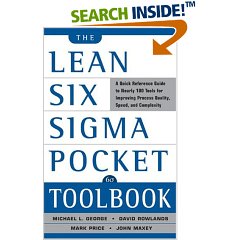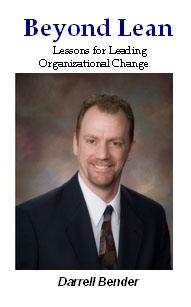LOM 4326/5326 - Quality Assurance in Business
This description will be updated and will become more detailed for the
Winter 2007 semester.
Statistics Resources on the web
Paper syllabus
Leader:
Robert J. "Bud" Banis, Ph.D.,C.M.A.
CCB 230 314-516-6136; 636-394-4950
E-mail rbanis@jinx.umsl.edu
MW 8-9:15 am in SSB 102
Prerequisites: Math 100 - Basic Calculus
Math 105 - Basic Probability and Statistics
BA 103 - Computers and Information Systems
minimum 2.0 Campus GPA
COURSE DESCRIPTION & OBJECTIVES:
This is primarily an applied statistics course dealing with philosophy
and mechanics of statistical approaches to quality management. It
is assumed that the student is acquainted with basic probability and statistics,
and basic use of a PC-Compatible computer, including navigating on the
web, fundamental concepts of spreadsheets, and e-mail. We will review material
from the prerequisites and then build on those to survey the tools of Statistical
Quality Management and their application to practical cases. Emphasis is
placed on problem definition, construction of statistical models, analysis
of data, and interpretation of results. Students will develop a report
at the end describing application of the tools in local organizations.
Prerequisites:
BA3320/5320 or Graduate standing. Familiarity with basic statistics and
PC-compatible computers, spreadsheets, email, and use of the internet..
Tentative GRADING:
Two Exams 400 points
Group Quizzes and cases 200
Case exercises 200
Application oral & written reports (last two weeks) 200
Total 1000 points
Exams are closed book, one page (2-sides) notes, multiple choice, short
answer. All Case exercises are individual effort only. Submissions
very similar in form and /or content will result in zeroes. The application
Report may be small groups with individual parts identified. Letter grade
breaks are expected to be around 90, 80, 70, 60%. Plus & minus grades
are rare. Application Report quality will be used to decide on borderline
cases.
Required:
You shouldn't need a complex statistical calculator as complex calculations
will be done mostly in EXCEL
Tentative Schedule:
Group Quiz one will be finished in class
on January 25. This is the only quiz given out ahead of time, the rest
will be in class.
Approx. date
Topic
Jan-16-18
Introduction & Overview of tools
Powerpoint overview 6-Sigma,
Taguchi Quality function
Quality Masters (Ch2)
Deming's Red Bead
Experiment description
Data manipulation and cleanup in EXCEL,
Sorting, graphing, statistical functions
Variance and Standard Deviation:
Measures of central tendency dispers.xls
: dispersity example with calculations of variance dispersolver.xls
Areas under the normal curve-- the Z
score table. as an excelfile, ztblcalc.xls
Applications to normallized scores--the IQ
Score examples
Central Limit Theorem
Google search on Central
Limit Theorem
Sampling Statistics and confidence limits on estimates of parameters.
Sampling from Airplane empty seats data airseats.htm
videotutorial on sampling, samplek.html
Other videos on excel analysis of characteristics of the distribution
of sample means:
Finished spreadsheet results show Central
Limit Theorem on distribution of sample means.
Exercise 1: Sampling and the central limit theorem.
Due Thursday February 8
using the random sampling procedure, collect 20 samples of size n=25
from the airplane empty seat data. airseats.htm
derive means, standard deviations and 95% confidence intervals for
estimates of the population mean for each of the 20 samples.
compare histograms of the original distribution and the distribution
of sample means.
Turn in the resulting spreadsheet printed to be 1 page (legible)
with your name, section and student number printed at the top of the sheet.
You can accomplish this by printing a selected range that leaves out some
of the original data.
video on print
to 1 page
Also submit a file via the dropbox I put in Mygateway under
course documents.
1) How many of your samples had intervals including the true mean?
2) How many gave an erroneous estimate?
3) What is the expected frequency of errors in estimating the population
mean when you use a 95% confidence interval? Was your observed result close
to that expectation?
4) State the three characteristics we expect to see in the distribution
of sample means from the Central Limit Theorem.
5) Are your results reasonably consistent with those expectations? |
probabilities of multiple errors
in the sampling experiment. Normal approximation to binomial distribution.
Evidence for carcinogenicity of
Dioxin.
Hypothesis testing and sample means
See Lean Six Sigma Pocket Toolbook, pp.156-165
Example one-sample t-test:
Is hospital length of stay <
5 days?
video on 1-sample
t-test Beta error & sample size losbeta.xls
T-test two sample means:
gender and height data from statistics
class
video on 2-sample
t-test
height data 2
sample t test completed
Hypothesis testing, General overview h0test.pdf
Quiz 2 review
Analysis of Variance
Concepts of ANOVA , "explaining
variance" Where does it come from and how can you mathematically separate
out the sources of variation?
Ho: all means are the same
Ha: at least two differ from each other.
If Ho is rejected, Which ones are different from which?
Least Significant Difference (LSD) good discussion at http://helios.bto.ed.ac.uk/bto/statistics/tress6.html
basically, LSD= t(alpha,dferror)*sqrt((2*MSE)/n) also see the Multiple
Range test with a studentized range.
Summers Text, p. 133 clutch plate keyways ungrouped and grouped
data.
Is there evidence that the keyways differ in depth?
Completed keyway sheet
with grouped data histograms and ANOVA
Analysis of Variance (ANOVA), Toolbook, pp.173-179
Capsule summary of concept of ANOVA, Summers, p339
Two-way ANOVA:
golf ball data --correcting for
the effect of other variables
Videos on the golf ballcase with one-factor
and two-factor
ANOVA
What is "Interaction"?
Finished sheet for golf ball data
and Discussion of results
Recorded classes from Statistics course on the golf-ball case Winter
2006 Statistics course
EXCEL model showing partition
of Variance by averaging out different effects. Be sure to
set Tools >Macro >security at "medium" and enable the macros
so the drop down list works.
| I'll run through all this in class to show exactly how I would do
it before you do it.
Exercise 2: Problem 9-4 p.172 plastic
trim
The question is whether Mary and Jack are trimming the same amount
from the parts coming from Press #1.
To look at this thoroughly:
1) We'll do a histogram of combined data vs. data separated into Jack's
and Mary's products. Use bin size of 0.0005 from 0.6530 to 0.6600 (15 bins)
2) We'll consider whether time of the sample gives a huge contribution
to variance by doing a one way ANOVA (4 times represented) separately for
Jack and Mary.
3) produce descriptive statistics for the distribution of values produced
by each worker, including upper and lower 95% confidence limits. In order
to do this, data will have to be reconfigured to be all in one row for
each. Is there evidence that the two have significantly different means
from these results?
4) We'll do an F test, 2-sample for variances to determine if the two
operators have significantly different variances, followed by the appropriate
t-test. Interpret the F-test output and the T-test output.
What do you conclude about the difference between the two operators?
|
The paired sample t-test--correcting for unknown common factors
Blood pressure readings- comparison of two methods:
Paired t-Test versus t-Test without pairing. Diastolic blood pressures
(DBP) Readings were made by two devices. The diastolic blood pressures
(DBP) of 60 patients were determined using two techniques: the standard
method used by medical personnel and a method using an electronic device
with a digital readout. The results are given in a TXT file bpdigi.txt
We will analyze these data to determine if the two techniques give
significantly different results.
First, we'll use the t-test for comparison of two means, ignoring the
pairing of the data, then we will analyze differences between the pairs,
using each individual as his own control for variables other than the reading
technique. This is also used as a "before and after" type experiments.
Finished
sheet for the BPDigi paired t-test.
Chapter 10: Variable Control Charts
Data table on Clutch plate thickness
from Summers Book (p176, again on p138, again on p218) sheet
in progress on clutch plate control charts
We plotted a time series of the clutch plate thickness sample (n=5)
averages and added in lines for LCL and UCL where these are = mean +/-
3SEM
We also plotted an R-barchart using Shewhart's D3 and D4 factors from
the table in the book X-bar&R-barcharts
Shewhart Factors table scanned
from book
Roller shaft length data p184-185
with a Sheet in process
| Mar 24-Apr 1 spring break |
Different ways to arrive at Limits and use of Standard deviations for S
charts:
Process Capability, Chapter 11.
Control Chart Patterns and Process Capability Powerpoint
Process Capability Ratio, Cp and Process Capability
Index, Cpk figure
Exercise 3 (due Thursday, April 12):
X-bar and R-charts
Data from Question 10-3, p212
datatable in EXCEL
Setup X-bar and R charts as I did in class where:
X-bar chart:
centerline = Xbarbar
use R-bar calculated as the mean of sample R's. The UCL and LCL are
Xbarbar+/- A2*Rbar
Range Chart:
Centerline= Rbar which is calculated as the average of the sample Ranges.
LCL=D3*Rbar
UCL=D4*Rbar
1) Interpret the charts. Does the process seem in control?
2) Are there some points that probably have assignable causes that
might be eliminated once those causes were identified?
3) If the Average fill of the bags is supposed to be 50.0 pounds, how
does the process history compare to that goal? |
Attributes Control Charts:
Confidence interval on Population Proportions:
The same tools apply as for continuous variables except that the mean
of a population is approximated by the proportion of "successes" in the
sample data, and the variance is estimated by p*(1-p).
Thus the equivalent of sample distribution SEM is the sqrt((p*(1-p))/n).
Because we assume an approximation to a continuous variable, it's important
the p not be near 0 or 1.0. The test for appropriateness is that a 99%
confidence interval doesn't include 0 or 1.0.
New Jersey Drug Testing
Attributes Charts (Chapter 13):
1) Fraction Defective (p) Charts (constant sample size).
Proportion defective = p = np/n where np=number
defective, n= sample size.
Centerline = pbar
3-sigma control limits = pbar +/- 3 * sqrt(pbar(1-pbar)
/ sqrt (n)
example: Credit Card
Data, pp 259-260and265
If sample sizes vary, it is best to calculate pbar
as a weighted average.
Percent defective = exactly the same, but
everything multiplied times 100
Number defective = exactly the same, but
just count the number defective each sample and plot that.
3-sigma limits calculated as npbar +/- 3* sqrt(
npbar*(1-pbar)) is the same as calculating everything using pbar,
then multiplying all terms times n.
2) C-Chart: Counts of Defects per piece with n=1
Sample size is one unit. centerline = cbar avceraged
over all samples.
Control Limits = cbar +/- 3 * Sqrt (cbar)
Example: Rolls of paper
p.271-272
3) U-Chart Average of Defects per Unit (n>1) Constant sample size.
u = c/n . Centerline = ubar
Control limits = ubar +/- 3 * sqrt(ubar) / sqrt(n)
Example: hose connectors
p276
If sample sizes vary, it is best to calculate ubar
as a weighted average.
Joint Probabilities and Independence:
-
Joint events rain
-
Independence and the Chi-Square test.
-
Categorical Analysis Chi Square tests
of independence-- drinking and smoking.
-
U. Cal. Berkeley Graduate School Admission Sex-bias Data
analysis by pivottable and Chi-square
Exercise 4: Simpson's Paradox: Due Thursday April 19.
Use the Berkeley partial dataset provided set up the pivottable and
Chi-squared analysis as described. Use the page variable to filter the
data and record the admission percents for males and females and Pvalues
for each department.
Discuss the the results of departmental analysis versus aggregate analysis.
refer to the references and any others you find useful to explain what
happened and what it means. |
-
You could also add conditional formatting to highlight which sex is favored.
Reliability (Ch14)
Acceptance Sampling:
Powerpoint show
from Heizer-Render (start slide 64)
Operating Characteristics Curve from Ng
(2003) J. Stats Ed
EXCEL File for sampling strategy and
Operating Characteristic
Failure Modes and Effects Analysis (FMEA) Ch15
FMEA Powerpoint Show from
Summers textbook
Links to Many other examples on FMEA
Wikipedia Description FMEA
FMEA InfoCenter Mainpage
http://www.fmeainfocentre.com/presentations1.htm
Outstanding Site on Six Sigma tools in general:
Six Sigma First
Design of Experiments (Ch16):
Powerpoint from Summers Book DOE
Lean Manufacturing (ch17):
Powerpoint from Summers Book Lean
Mfg.
Book Report on Beyond Lean by Darrell Bender:
Due Last class, May 3.
about a page, please send it in electronic form in the dropbox I put
in mygateway under assignments.
Read the book and comment on:
1) What kinds of things can go wrong in a Lean Implementation.
2) Managment usually buys into quality/efficiency programs such as
Lean, Six Sigma expecting reductions in costs. Many people feel cost reductions
necessarily equate to eliminating people from the organization. Some people
assume "Lean"="Mean". Is that necessarily true? explain?
3) How is it possible for business leaders to both pursue profit for
the shareholders as well as a beneficial and humane environment for the
employees? |
Last Class Thursday, May 3
Exam #2-Tuesday May 8 10-12 noon. Cumulative, covers whole semester, will
have some repeats from exam 1.
Text books:
E-mail: bud_banis (at) umsl.edu
Campus office CCB 230
On-campus phone 314-516-6136
Off-campus 636-394-4950
 Return
to Bud's Page
Return
to Bud's Page
Miscellaneous Statistics issues in the news:
| IPCC Climate Change 2007 on Global Warming reports low confidence in
the conclusions |
http://politicallycorrecteconomics.com/ |
| annotated IPCC summary for Policy Makers |
IPCC
Summary |
| NASA data on Temp anomalies |
tempanom.xls |
| Studies on Youth Risk Behavior "Prove conclusively" that sexual activity
in highschool students is related to poor dental hygiene |
YRBS03data and pivottable
analysis followed by ChiSquared test for independence |
|
|
 Go to UM-St. Louis Home Page
Go to UM-St. Louis Home Page
 Go to UM-St. Louis School of Business Page
Go to UM-St. Louis School of Business Page
last modified April 30, 2007~~ comments and suggestions to
bud_banis (at) umsl.edu






 Return
to Bud's Page
Return
to Bud's Page
![]() Go to UM-St. Louis School of Business Page
Go to UM-St. Louis School of Business Page